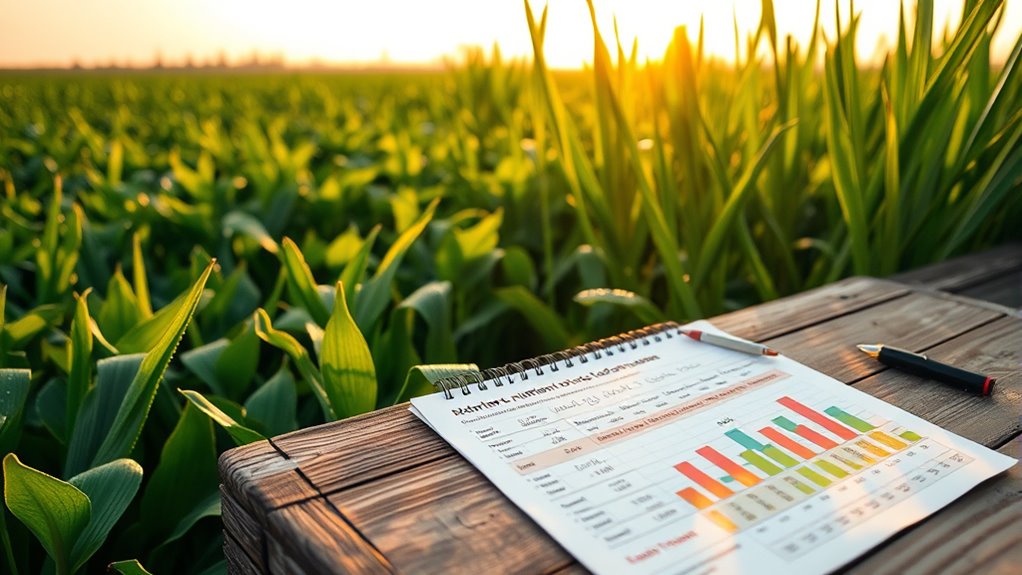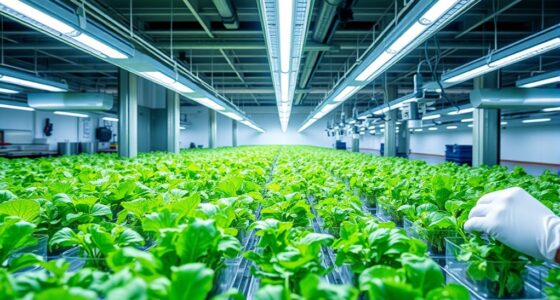To scale up and calculate nutrient costs per kilogram harvested, first track all nutrient expenses like fertilizers, feed, transportation, and application costs for the crop cycle. Then, measure the total nutrients applied in units such as kilograms or pounds, based on application records. Divide your total nutrient costs by the total harvest weight to get the cost per kilogram. Keep these steps in mind to better manage costs, and you’ll discover more ways to optimize your nutrient use.
Key Takeaways
- Accurately record total nutrient expenses, including purchase, transportation, and application costs over the crop cycle.
- Measure total nutrients applied in units like kilograms or pounds during the same period.
- Determine harvest weight in kilograms or tons and divide total nutrient costs by this amount for cost per unit.
- Adjust nutrient cost calculations based on nutrient use efficiency to reflect actual nutrient uptake.
- Analyze cost trends over multiple harvest cycles to identify inefficiencies and optimize nutrient management strategies.

Have you ever wondered how to accurately determine the cost of nutrients in your feed or fertilizer? Understanding this helps you make smarter decisions about input investments and budget management. To do this effectively, you need to link the total nutrient cost to your harvest output, which requires calculating the nutrient cost per kilogram of produce. First, gather the total amount spent on nutrients for a specific period or crop cycle. This includes the purchase price of fertilizers or feed supplements, any transportation costs, and application expenses. Once you have the total expenditure, identify the total quantities of nutrients applied during that period, usually expressed in units like kilograms or pounds of nitrogen, phosphorus, and potassium.
Calculate nutrient costs per kilogram of harvest to optimize input investments and improve farm profitability.
Next, you’ll need to determine how much harvest you’ve produced in that same period. Measure your yield in kilograms or tons, depending on your operation’s scale. The goal is to relate the total nutrient cost directly to the amount of crop or feed produced. Divide the total nutrient expenditure by the total harvest weight to get the nutrient cost per unit of produce. For instance, if you spent $5,000 on nutrients and harvested 10,000 kilograms of crop, your nutrient cost per kilogram would be $0.50. This figure tells you exactly how much you’re investing in nutrients for each kilogram of output.
However, to make this calculation more precise, consider the efficiency of nutrient uptake by your plants or animals. Not all applied nutrients are absorbed; some may leach away or remain unused. If you have data on nutrient use efficiency, factor that into your calculations to better estimate the true nutrient cost associated with the nutrients actually incorporated into your harvest. You might adjust your costs based on the percentage of nutrients utilized, providing a clearer picture of the real investment per kilogram. Additionally, understanding nutrient absorption rates can help refine your cost calculations and improve overall fertilizer management.
Furthermore, tracking these costs over multiple harvest cycles allows you to identify trends and optimize your input strategies. If nutrient costs per kilogram are rising, it may indicate inefficiencies or the need for different fertilizer formulations. Conversely, decreasing costs could point to improved management practices. Using this approach, you can compare different fertilizer sources or application methods to find the most cost-effective options, ultimately maximizing your return on investment.
Frequently Asked Questions
How Do Seasonal Changes Affect Nutrient Cost Calculations?
Seasonal changes impact nutrient cost calculations by altering plant growth rates, soil nutrient availability, and environmental conditions. When seasons shift, you’ll notice fluctuations in nutrient needs, so you must modify your calculations accordingly. Warmer months might increase nutrient demand, raising costs, while cooler periods could reduce needs. By monitoring these changes, you ensure accurate budgeting and efficient nutrient use, ultimately optimizing your harvest and maintaining crop health throughout the year.
What Tools Are Best for Real-Time Nutrient Cost Monitoring?
Ever wonder how you can stay ahead of fluctuating costs? You should consider using digital tools like farm management software or real-time monitoring apps. These platforms track nutrient usage, costs, and environmental data instantly, helping you make informed decisions quickly. Do you want to optimize your nutrient expenses and improve crop yields? Investing in such tools allows you to respond proactively to changes, saving money and boosting productivity efficiently.
How Do Crop Varieties Influence Nutrient Cost Efficiency?
Crop varieties considerably influence nutrient cost efficiency because some are bred for higher yields with less fertilizer, while others require more nutrients to reach their potential. When you select a variety suited to your local conditions, you optimize nutrient use and reduce expenses. By choosing the right variety, you can maximize harvests, minimize waste, and improve overall cost efficiency, making your farming more sustainable and profitable.
Can Nutrient Costs Be Reduced Without Affecting Yield Quality?
Yes, you can reduce nutrient costs without sacrificing yield quality by optimizing your fertilization practices. Focus on soil testing to apply only what’s needed, use precision agriculture tools to target specific areas, and choose efficient, slow-release fertilizers. Additionally, adopting crop rotation and cover cropping can improve soil health, reducing dependency on external nutrients. These steps help lower costs while maintaining high-quality yields.
What Are the Long-Term Financial Benefits of Precise Nutrient Calculations?
By calculating nutrient costs precisely, you can maximize your farm’s profitability over time. For example, a hypothetical farm that fine-tunes its fertilizer application reduces waste and boosts crop yield quality. This approach lowers input expenses and increases crop value, leading to higher profits in the long run. Ultimately, you’ll enjoy consistent financial gains, better resource management, and more sustainable farming practices that support your business’s growth.
Conclusion
Now that you’ve learned how to calculate nutrient costs per kilogram, you’ll be better equipped to make informed decisions on your farm. Remember, this isn’t just some fly-by-night task; it’s as vital as a knight’s armor in battle. By keeping tabs on your expenses, you’ll guarantee your harvests stay profitable and sustainable. So, don’t let this knowledge gather dust—use it to stay ahead in the game, just like a savvy rancher of yore would!










